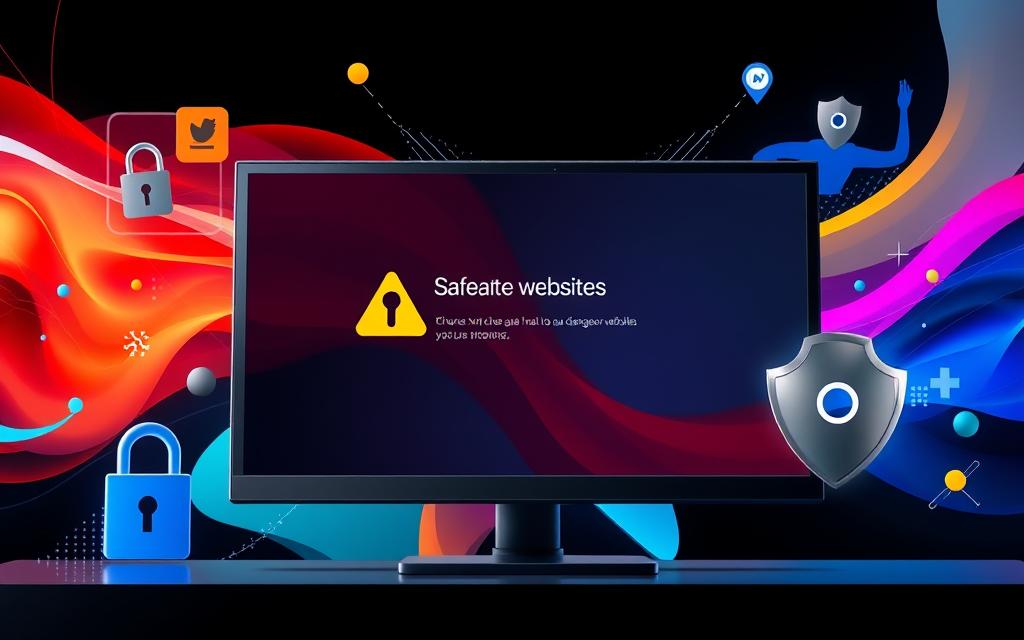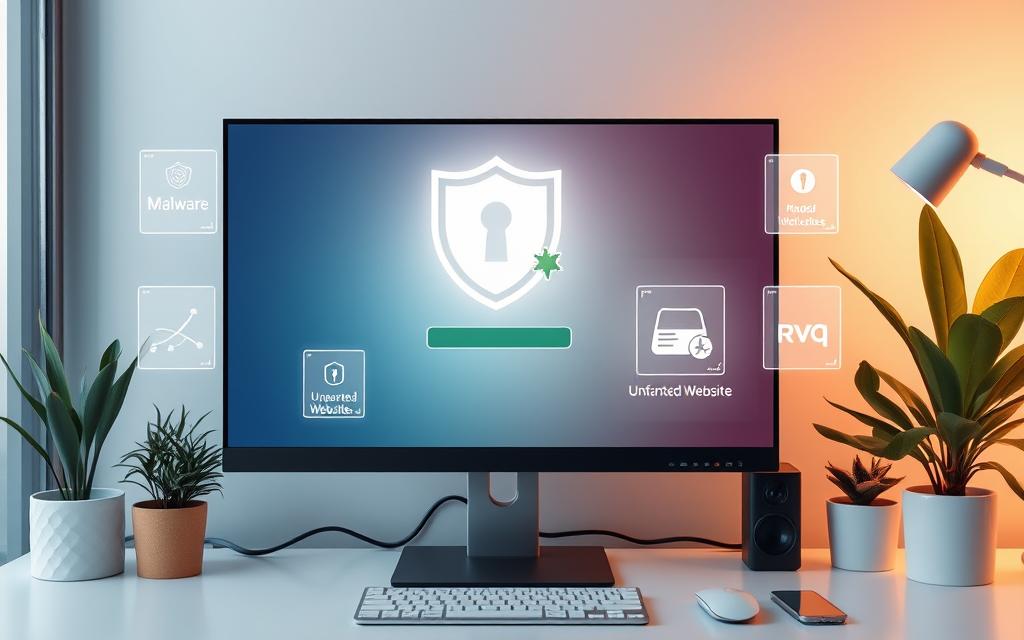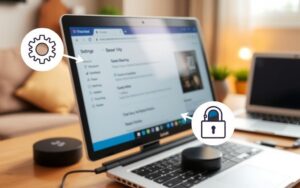Table of Contents
In today’s world, knowing how to remove unwanted websites from your PC is vital. It helps keep your computer safe and your browsing smooth. Unwanted software and malware can mess with your computer, like changing browser settings. This might lead to your homepage going to ads or a strange search provider taking over, often for making money.
Toolbars and add-ons you didn’t ask for can make it seem like websites won’t leave your PC. But the real issue usually comes from harmful software, like viruses, spyware, or PUPs. So, it’s better to focus on getting rid of these unwanted programs. Instead of trying to remove websites directly, aim to get rid of unwanted software messing with your browser.
If you’re troubled by ‘weknow.ac,’ a sneaky service that tries to steal your data, you need to act. Reset your browser settings, check for unwanted toolbars, and use tools like Kaspersky or Malwarebytes for malware removal. For tips on blocking such pesky websites and making your browsing better, check out this helpful guide on how to block websites on your PC.
Identifying Unwanted Software and Malware
Spotting malware and unwanted software is tough for users. Early detection is key to keep personal and sensitive data safe. You may notice different signs if your device is infected. Knowing these signs helps protect your devices quickly.
Common Symptoms of Malware Infection
It’s critical to know the signs of unwanted software to keep your computer safe. Key symptoms to watch for include:
- Unexpectedly slow computer performance
- Frequent pop-up ads appearing on the screen
- Altered browser homepages or unfamiliar toolbars
- Redirects to unknown websites during browsing
These signs often mean malware is present. Cybercriminals use such methods for browser hijacking. It’s crucial to stay alert.
Pop-up Ads and Browser Redirects
Pop-up ads are annoying and may indicate a malware infection. They could lead to phishing, where you’re tricked into revealing personal info. Browser redirects may happen too, taking you to sites that spread malware or steal data.
Keep your security software up to date to fight these threats. It helps in spotting malware and removing unwanted software. If you see these symptoms, run security scans and check your browser extensions right away.
Using Chrome’s Safe Browsing Features
Chrome’s Safe Browsing features help you stay away from harmful websites and malware. They make browsing safer by alerting you to threats. You can turn on Safe Browsing and control ads for a better experience.
Enabling Safe Browsing Mode
To enable Safe Browsing, go to Chrome’s security settings. This feature has been protecting users since 2005 by checking sites for dangers. The Enhanced Safe Browsing option offers the best protection by checking sites in real time. It helps fight against phishing and malware by scanning for security risks. Learn more about it here.
Setting Permissions for Intrusive Ads
By managing ad permissions, you take charge of your online ads experience. This allows you to block or allow ads based on what you prefer. Adjusting these settings leads to a more pleasant and safer browsing. You can also choose which ads to see and which to block.

How to Get Rid of a Web Site on PC
To get rid of unwanted websites on your PC, start with a few simple steps. First, look for any malicious extensions installed without your OK. Then, reset your browser settings to clear any changes made by malware. Here’s how you can do these tasks.
Removing Malicious Extensions
If you see strange websites popping up, it could be due to malicious extensions. Here’s how to get rid of them:
- Open your browser.
- Go to the menu, usually at the top right.
- Choose Extensions or Add-ons.
- Search the list for anything odd or suspicious.
- Press Remove for the extensions you wish to delete.
After dealing with these malicious extensions, you should reset your browser settings.
Resetting Browser Settings
Resetting your browser wipes out malware leftovers and unwanted changes. Here’s what to do:
- Find your browser’s settings menu.
- Search for Advanced Settings or Reset Settings.
- Choose Restore settings to their original defaults or something similar.
- Agree to it when asked.
With these steps, you can remove unwanted websites on your PC and keep your browsing safe.
| Browser | Percentage of Users Who Use Extensions | Commonly Installed Malicious Extensions |
|---|---|---|
| Chrome | 60% | Ad Blockers, Toolbars |
| Firefox | 55% | Privacy Tools, Fake VPNs |
| Safari | 30% | Data Harvesters, Pop-up Blockers |
| Edge | 40% | Notable Extensions, Shopping Assistants |
Manually Removing Unwanted Programs on Your Mac
Deleting programs from your Mac can seem tough at first. But if you follow the right steps, it’s quite easy. Most users get rid of unwanted apps using tools like Launchpad and Finder. This not only makes your Mac run better but also keeps it safe by getting rid of risky software.
Guided Steps to Delete Unwanted Applications
If you want to start cleaning up, head to the Applications folder first. It’s where all your apps are stored. Here’s what to do:
- Open Finder and click on ‘Applications’ from the side menu.
- Look for apps you don’t recognize or need anymore.
- Drag these unwanted apps to the Trash to remove them.
- Empty the Trash to fully get rid of the apps.
For apps you got from the App Store, Launchpad makes deleting them simple. Just click on Launchpad, find the app, and press and hold its icon. When it shakes, click the ‘X’ to delete it. However, remember, deleting apps might not remove all their data. To completely clean up, you might need to manually check folders like ~/Library/Application Support or /Library/Caches.
Cleaning Up Your Trash
It’s vital to clean your Mac’s trash after deleting apps. Just removing them does not get rid of all their data. To properly clean the Trash:
- Right-click the Trash icon in the Dock.
- Choose ‘Empty Trash’ to completely erase the apps and their leftovers.
This routine helps avoid left-behind files using up space or causing issues. For more help, check out Apple’s support page. It provides more details on these steps. Learning these clean-up methods not only eases the process but also ensures a smoother running Mac.
Preventing Future Malware Infections
As malicious activities online increase, it’s crucial to use effective strategies against malware. Being watchful and applying specific practices can cut down the risk of harmful software. Knowing how to spot risky websites and ensuring safe downloads are key.
Spotting Suspicious Websites
Many malware issues start with internet browsing. Spotting dodgy websites helps avoid malware. Be cautious with websites from places known for malware, like Russia, China, and South Korea. Use the Scam Website Checker to check site safety. Also, ad-blockers can stop dangerous ads on even good websites.
Avoiding Unsafe Downloads
Downloading carelessly often brings malware. Always use official sites for downloads, and ignore software offers in ads. Some installers pack in extra, unwanted software that could be harmful. Be wary of email attachments and links, as they are common malware sources. And be careful on file-sharing sites.
Importance of Regular Virus Scanning
Having active anti-malware protection is crucial. Regular scans help find and fix security weak spots. Updating systems and using firewalls and intrusion systems also help protect against malware. Since over 90% of infections happen while browsing, staying alert is key for safety.
Conclusion
Keeping your PC safe by removing harmful websites is crucial. By identifying and getting rid of malware, using tools like MalCare, and checking your system often, you keep your computer safe. These steps lower the chances of attacks that could steal your data.
If you see any strange activities, it’s important to act fast. Ignoring them can harm your website’s reputation. With things like Google Search Console and scanners, you can find problems early. This helps stop damage before it starts, keeping your digital space secure.
Taking good care of your digital security improves how you use the internet. Stay on top of maintenance, watch for dangers, and use reliable security. This way, you make your online world safer.
FAQ
What are the common signs of unwanted software on my computer?
Unexpected pop-up ads and changes to your homepage are common signs. You might also see unfamiliar toolbars. Plus, your web searches may redirect you to unknown sites. Alerts about infections could also pop up on your screen.
How does Chrome’s Safe Browsing feature enhance security?
Chrome’s Safe Browsing warns you about risky sites. It blocks access to dangerous websites. This protects you from malware and other threats.
What steps can I take to effectively remove unwanted extensions from my browser?
To remove unwanted extensions, head to your browser’s settings. Find the extensions page and look for suspicious ones. Remove these and reset your browser to its original settings.
How can I manually remove unwanted programs from my Mac?
To remove unwanted apps, go to the Applications folder. Look for apps you don’t recognize and delete them. Make sure to empty the Trash to completely get rid of them.
What practices can help prevent future malware infections?
Avoid visiting suspicious websites and downloading unsafe files. Regularly scan your device for viruses. These steps can keep your computer safe.
Why is it important to regularly scan for malware?
Scanning for malware helps find and eliminate threats. It’s vital for keeping your computer safe. This way, your personal info stays secure from hackers.









